
Search
The Renewable Energy site for Do-It-Yourselfers
$1000 Solar Water Heater --
Performance
|
Long term performance plots for the
our solar water heating system are provided below.
The first full year of operation is covered.
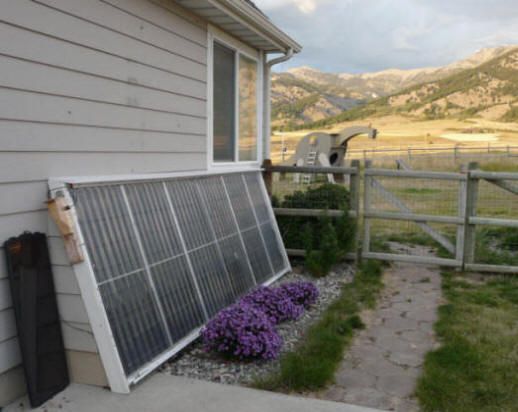
Our solar domestic
hot water collector after one year of service.
The material below includes performance for a full year, as
well as 5 minute interval plots showing collector, tank, and ambient
temperatures.
|
|
Performance Summary for First Full
Year of Operation
Over the first full year of
operation, the system met 95% of our hot water needs. The plot below shows
the Solar Fraction for each month.
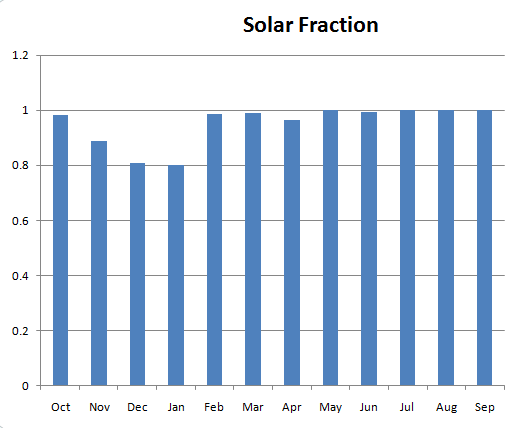
The plot shows the Solar Fraction by
month -- the solar fraction for the year was 0.95. We were out of town for
all of January, so in the estimate of Solar Fraction for the year, I assigned
January a solar fraction equal to the lowest other month (0.8).
This is an unusually high Solar
Fraction for a domestic water heating system. Some of the reasons for this
include:
So, if you build the system, you
should not necessarily expect this high a solar fraction. Depending on
your demand, your climate, and how you size the system you may see a lower solar
fraction. But, even if you set your target somewhat lower, your system
will still save a lot of money and carbon, and will perform well compared to
commercial systems.
The aim of tracking the performance
and estimating solar fraction for a full year is not to calculate solar fraction
to a gnat's eyebrow, but simply to show that a homemade system that you can
build at a very low cost can perform well, and offer a very good return on your
investment.
Here are some additional
notes on how I define and calculate Solar Fraction,
and how this compares with other performance metrics...
I don't plan to do any more logging
of the performance of the system -- I need to get my data loggers back for other
projects!
If there are any further developments
(good or bad), I will post them.
Other performance test results for
the system:
Quite a bit of performance and
durability testing has been done on this system other than they long term
performance plots -- these other test results are here:
Small panel tests...
-- compare performance of PEX, copper and commercial collector model panels.
PEX/aluminum collector full size
prototype tests...
Copper/aluminum collector full
size prototype tests...
Pipe coil heat exchanger test ...
Copper/aluminum flow
distribution test ...
And, a
roadmap for all the files on the $1K Solar Water Heater project...
Long Term
System Performance Plots
Below are the monthly performance
plots for the first full year of operation of the $1K
Solar Water Heating System
I logged the top and bottom of tank
temperature, ambient temperature, collector temperature, and solar radiation
levels. For some of the tests, I also logged the supply and return
temperatures to the collector.
The solar fraction calculation is
explained below, but basically when the tank is at or above 110F no further
heating is needed, and it supplies 100% of the hot water -- if the tank
temperature is less than 110F, than, depending on the actual temperature, it
supplies a fraction of the water heating.
I want to make it very clear that our
hot water needs are minimal, and this helps to account for the very high solar
fractions we are getting with our not so large collector. I would
estimate that our total daily hot water usage is about 24 gallons. This is
not really the result of some big sacrifice -- we just don't use that much hot
water -- I actually think that the estimates you see up around 20 gallons per
person per day are too high for most people. If you use low flow shower
heads and don't use hot water for clothes washing, your hot water usage may not
be much more than ours.
Monthly Performance to Date:
Click the links below for a
performance plot and details for each month.
October
2008 ...
November
2008 ...
December
2008 ...
January
2009 ...
February
2009 ...
March 2009
...
April
2009...
May 2009 ...
June 2009...
July 2009...
August
2009...
September 2009...
October, 2008 -- 98.4% Solar
Fraction:
This plot covers from Oct 10 through
Oct 31 of 2008.
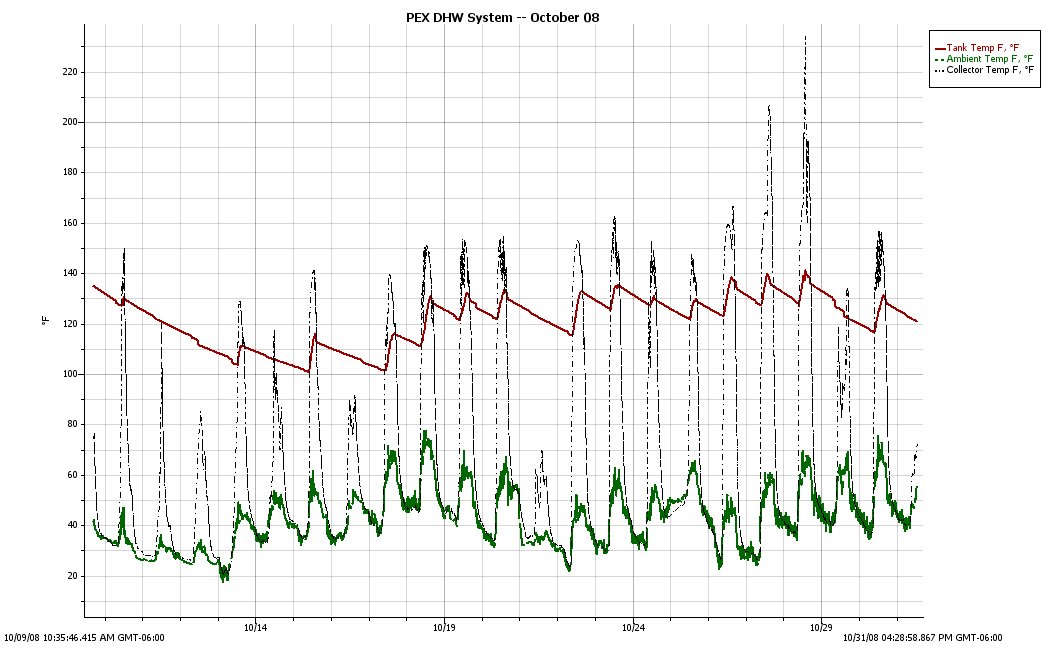
Red -- Tank temperature F
Green - Ambient Temperature F
Black - Temperature in the collector
cavity F
I monitored top of tank and bottom of
tank temperatures, but there was so little difference that I am just showing top
of tank temperature.
Our tankless water heater is set to
110F, so whenever the tank temperature is 110F or above, the tankless heater
does not come on and all heat is solar.
On 19 of the 22 logged days, the
temperature never dropped below 110F, so 100% of hot water for those days was
solar.
On the 13th, 15th, and 17th the
temperature dropped below 110F to about 103F -- On these days, about
(103F-50F)/(110F-50F) = 0.88 or 88% was solar.
So, the solar fraction for October
was about: (19/22)(1.0) + (3/22)(0.88) = 98.4%
Notes on October plot:
This October was a bit odd -- there
was a several day snow storm with as much as 6 inches of snow on the ground at
one point. But, the end of October was unusually warm. It was
overall less sunny than October usually is around here.
I will mention again that our hot
water needs are modest. There are only 2 of us, and we don't use hot water
for laundry at all. Given that the hot water is "free" I have been taking
rather long showers :)
There were several multi-day periods
with essentially no sun, and the large tank did prove to have enough storage to
weather these well.
You can see a few times where the
controller shut the pump off because the temperature got up to the 140F top
limit that I set for the tank water. On these occasions, the collector
temperature goes up to as much as 230F in one case because no water is flowing
through the collector to cool it. This is getting fairly close
to the upper long term limit for the PEX, but a warm sunny day in late fall is
probably about as hot as a collector tilted this steeply will get, because the
sun has nearly direct incidence on the collector near midday. So, I think
this will be OK.
The heat loss from the storage tank
seems high to me, and I do plan to add another layer of insulation on the
outside of the tank and to insulate the pipes near the tank.
November 2008 -- 89% Solar Fraction
This plot covers the full month of
November 2008
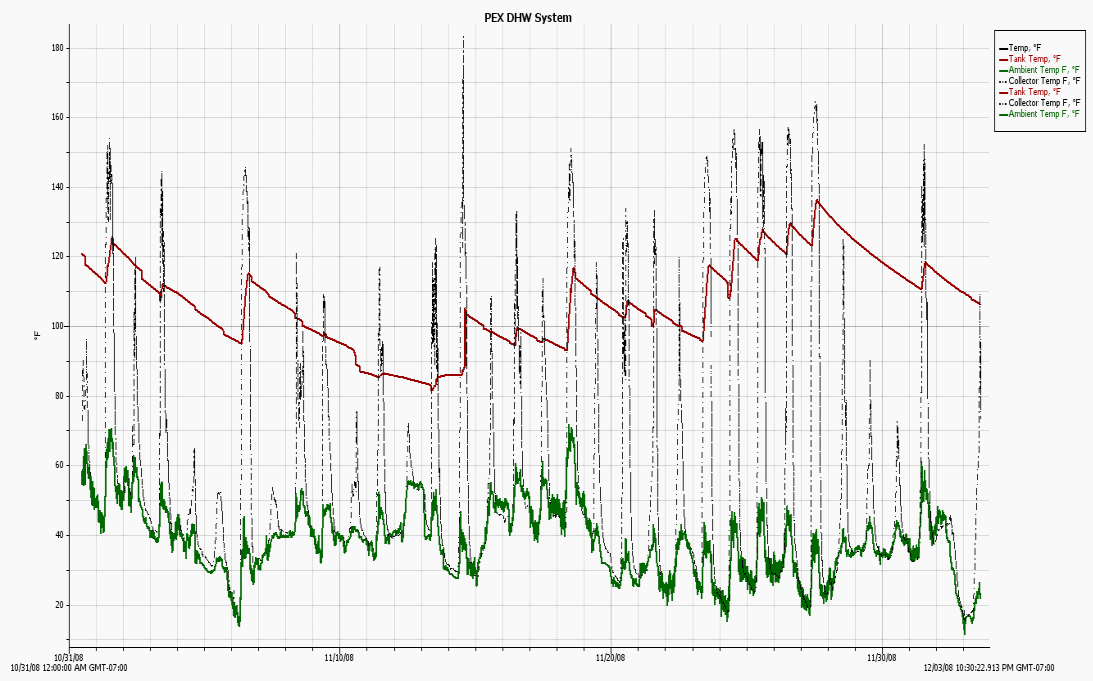
This is the performance plot for
November, 2008.
Red -- Tank temperature F
Green - Ambient Temperature F
Black - Temperature in the collector
cavity F
The lowest tank temperature was about
85F, and the highest was 136F.
Ambient high temperatures ranged from
a couple dazzling days that reached 70F down to a high of 35F on the coldest
day.
Ambient low temperatures ranged from
around 48F down to about 12F.
The highest inside of collector
temperature was 164F.
There were very few fully sunny days
(maybe 2) -- biggest tank temperature gain for one day was 21F (a little over 2
days worth of demand).
The calculated solar fraction for the
full month was 0.89.
This is calculated on a day by day
basis as follows:
Days when the tank temperature is
110F or more are 100% solar fraction.
Days when the tank temperature is
less than 110F, the solar fraction is
( (110F - 50F) -
(110F - TankTemp) ) / (110F - 50F)
Where 110F is the setting of
our tankless water heater -- it will not turn on if the solar tank is at
110F or more.
50F is the temperature of the
incoming water.
TankTemp is the early evening
(when we use most of our hot water) solar tank temperature.
For example, if the Tank Temp
is 100F, then solar has warmed the water up from 50F to 100F, and the
tankless water heater must add the last 10F to get to 110F. So,
solar is providing 5/6ths or 83% of the warming, and the solar
fraction is 0.83.
I use a spreadsheet to
calculate the solar fraction for each day and average them for the month
total.
For those in warmer climates, bear in
mind that November is a real winter month here in Montana. Here is a
picture taken near the end of the month -- the white substance is snow :)

Collector at end
of November.
To me, the month felt like we got
less sun than usual, but I have not tried to verify that against weather
records.
Anyway, an 89% solar fraction seems
quite acceptable to me for a winter month.
There were a few email questions on
how well the sloped serpentine PEX would drain back for freeze protection
-- there have now been quite a few night lows below 32F, and one
night approaching 10F, so it appears to be doing fine.
December
2008 -- 80.9% Solar Fraction
This plot covers the month of
December 2008
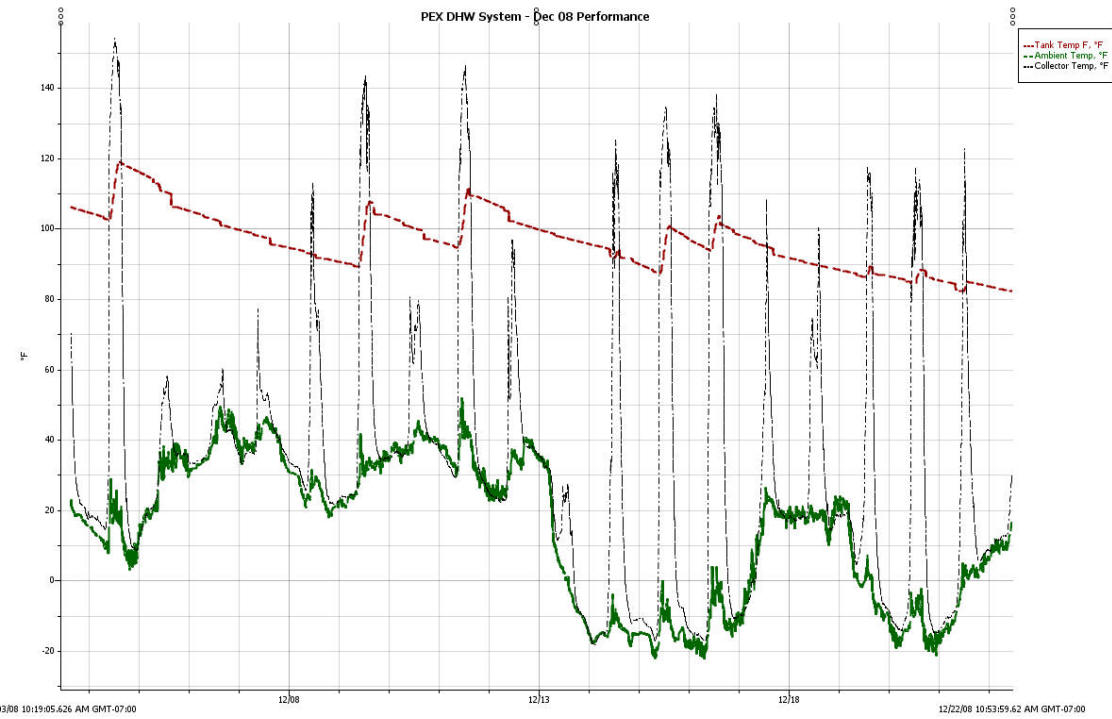
This is the performance plot for
December, 2008.
Red -- Tank temperature F
Green - Ambient Temperature F
Black - Temperature in the collector
cavity F
The lowest tank temperature was about
85F, and the highest was 119F.
Ambient high temperatures ranged from
about 47F down to a high of -5F on the coldest
day.
Ambient low temperatures ranged from
around 35F down to about -22F.
The highest inside of collector
temperature was 152F.
The calculated solar fraction for the
full month was 0.81.
This only includes from the 1st to
the 22nd (see explanation below).
Tankless Water Heater Problem:
We use a tankless propane water
heater to boost the solar heated water up to full hot water temperature (if
needed). On the 21st of the month, the tankless water heater heat
exchanger coil froze resulting in a split in one of the heat exchanger pipes.
When I applied the hair dryer the next morning to unfreeze it, it produced a
rather impressive leak. It was so close to Christmas that I decided
to just hook up our old water heater and use it over the Christmas period rather
than try to get the tankless repaired during the holidays. This temporary
setup keeps us from being able to use the solar heated water until I can get the
tankless unit fixed -- so, I only showed the part of the month in which we could
actually use the solar heated water.
I've not had a chance to discuss this
with Takagi yet, but its kind of surprising in that the vent line has a back
draft valve in it to limit cold air circulation through the heater, and there is
an electric heater that is supposed to come on to prevent freezing of the heat
exchanger -- oh well.
I'd add that this failure has nothing
at all to do with the solar water heating system, which continues to work just
fine.
This December was a very poor sun
month. We got the remains of the same bunch of storms that closed the
Seattle and Portland airports and left record snowfalls in Washington and
Western Montana. We also got some of the "Alberta Clipper" type very cold
air intrusions from the north. Usually these are accompanied by crystal
clear and sunny weather, but this month, they came with lots of clouds -- very
unusual. The net result was very few sunny days.
The solar fraction for the month is
still surprisingly good at 81%, but it would have been a bit lower had we not
had the failure of the tankless heater, because the end of the month (which was
not counted in the performance) was even
more cloudy.
The system handled the storms and
-20F temperatures with not even a hint of a problem.
January
2009 -- Solar Fraction Unknown
Basically, we were out of town for
the month of January, and I did not log any data.
February 2009 -- Solar Fraction
98.5%
This plot covers the month of
February 2009
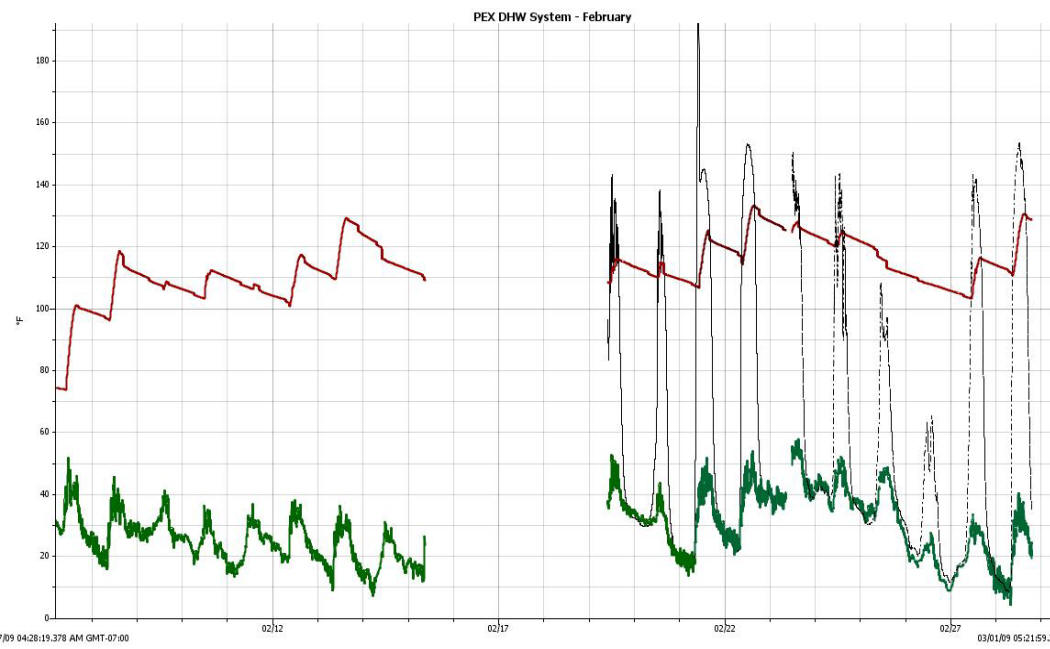
This is the performance plot for
February, 2009.
We were away until Feb 7, so the performance covers Feb 7 to Feb 28.
Data for Feb 16 through Feb 18 was
lost and is not included on the plot or in the solar fraction calculation.
Red -- Tank temperature F
Green - Ambient Temperature F
Black - Temperature in the collector
cavity F
The lowest tank temperature was about
98F, and the highest was 133F.
Ambient high temperatures ranged from
a couple days in the mid 50's F down to a couple days with highs around 30F.
Ambient low temperatures ranged from
around 35F down to about 4F.
The highest inside of collector
temperature was 190F for a very brief period on 1 day, but about 155F would be
more representative for the peak sunny day high.
Overall, the February weather was
very nice this year. We had about 4 fully sunny days, and perhaps
7 days that were part cloudy, but with enough sun to get some heat in the tank.
Overall, temperatures were milder than usual for Feb.
The calculated solar fraction for the
full month was 0.985 -- very nice, but probably a bit higher than an
average February would be.
We had the first failure -- The Steca
differential controller failed in such a way that it left the pump on at all
times. This was covered under the warranty, and the replacement controller
is back up and working fine. While waiting for the replacement controller,
in order to avoid having to turn the
pump on and off manually every day, I hooked up the old DC pump directly to a PV panel,
and used this arrangement for most of the month.
The reason that the plot above is a combination of several logs, and that some
days are missing is that I have been trying to log at a very short interval in
order to determine how well the PV panel is working as a controller (no
conclusions yet).
I would guess that the March and
April Solar Fractions may drop a bit as these are months we get a good part of
our yearly rain, and more cloudy weather -- will see.
March 2009 -- Solar Fraction
98.9%
This plot covers the month of March
2009
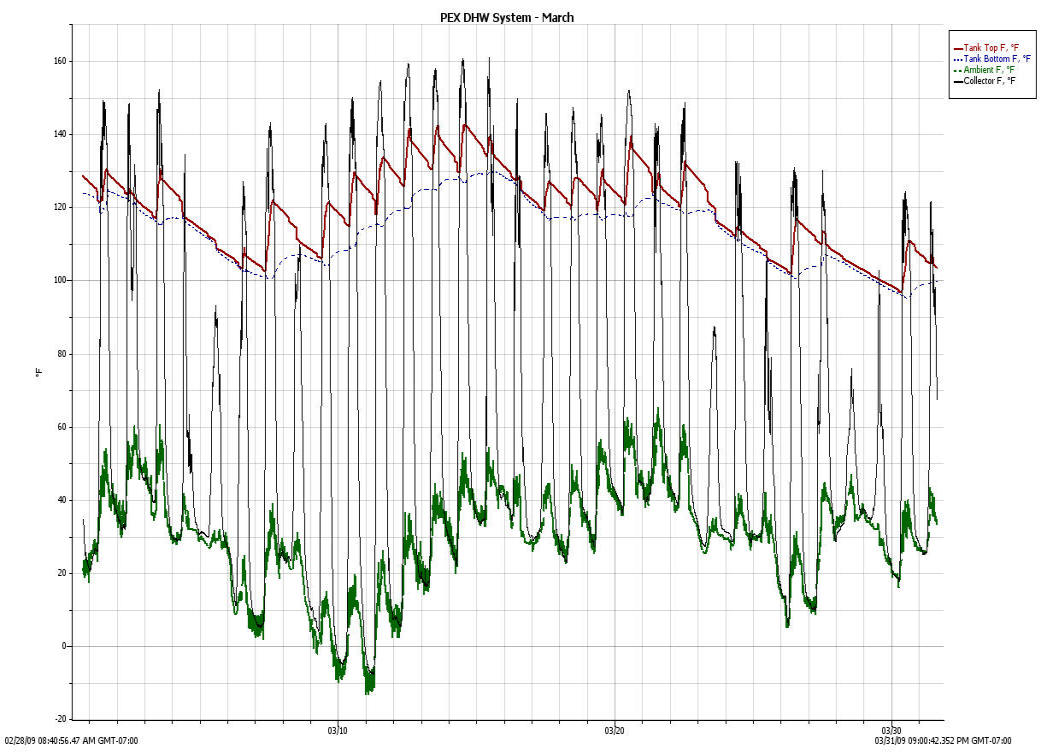
Red -- Top of tank temperature F
Dark Blue -- Bottom of tank
temperature F
Green - Ambient Temperature F
Black - Temperature in the collector
cavity F
The solar fraction was 98.9%.
This is based on a tank temperature of 110F or more being 100% solar fraction.
The lowest tank temperature was about
105F, and the highest was 142F (the controller shuts the pump off when the pump
inlet temp reaches 140F).
Ambient high temperatures ranged from
a couple days that reached 60F down to a the 9th with a high of 6F!
Ambient low temperatures ranged from
around 40F down to about -12F -- "bitter cold" as our weather man likes to
say.
The highest inside of collector
temperature was just over 160F on several days.
I left the bottom of tank temperature
in the plot this time because there seemed to be more variation between top and
bottom temps than past months.
Note that the hot water delivered by
the system will be at the top of tank temperature because this is where the pipe
coil exchanger/storage is.
Overall, March was probably a bit
sunnier than usual, but with a few very cold, snowy, stormy days. Most of
the sunny days were days of part sun with periods of cloudiness, but there was
usually enough sun to keep the tank above 110F. There were a few days
fully cloudy, stormy weather.
The calculated solar fraction for the
full month was 0.989 -- very nice -- probably a bit higher than a typical
March, which might have more clouds.
It is interesting to se that a few
sunny days will take the tank up to its limit temperature of 140F, even with
ambient temps down toward 0F.
April 2009 -- Solar Fraction
96.6%
This plot covers the month of April
2009
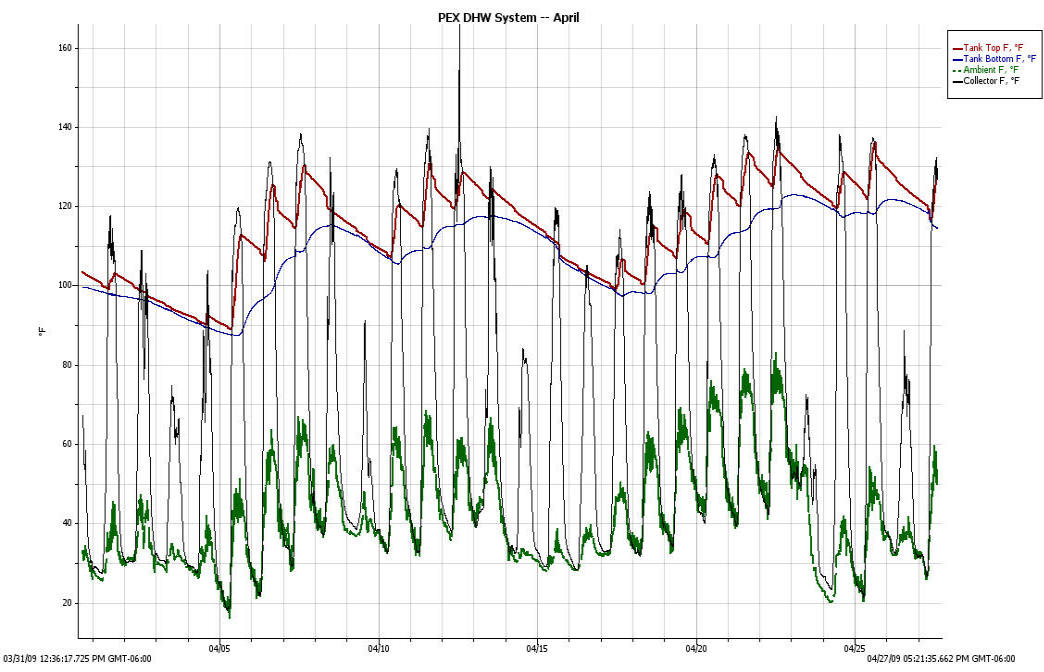
Red -- Top of tank temperature F
Dark Blue -- Bottom of tank
temperature F
Green - Ambient Temperature F
Black - Temperature in the collector
cavity F
We were away from home for the last
couple days of this month, so there is no data for the 29th and 30th.
The solar fraction was 96.6%.
This is based on a tank temperature of 110F or more being 100% solar fraction.
The lowest tank temperature was about
90F, and the highest was 138F (the controller shuts the pump off when the pump
inlet temp reaches 140F).
Ambient high temperatures ranged from
a couple day that reached 80F down to a few days with highs around 30F -- we got
a fair bit of snow in April.
Ambient low temperatures ranged from
around 48F down to about 15F.
The highest inside of collector
temperature was about 142F -- the 160+F temp on 12th was a stagnation test.
Overall, April was the usual mix of
very changeable weather -- everything from a day of 80F and sunny along with
several snow storms with accumulations up to a foot.
April and May are our highest
rainfall months with the most cloudy weather -- I believe that we get more
rainfall in May than Seattle does.
May 2009 -- Solar Fraction
100%
This plot covers the month of May
2009
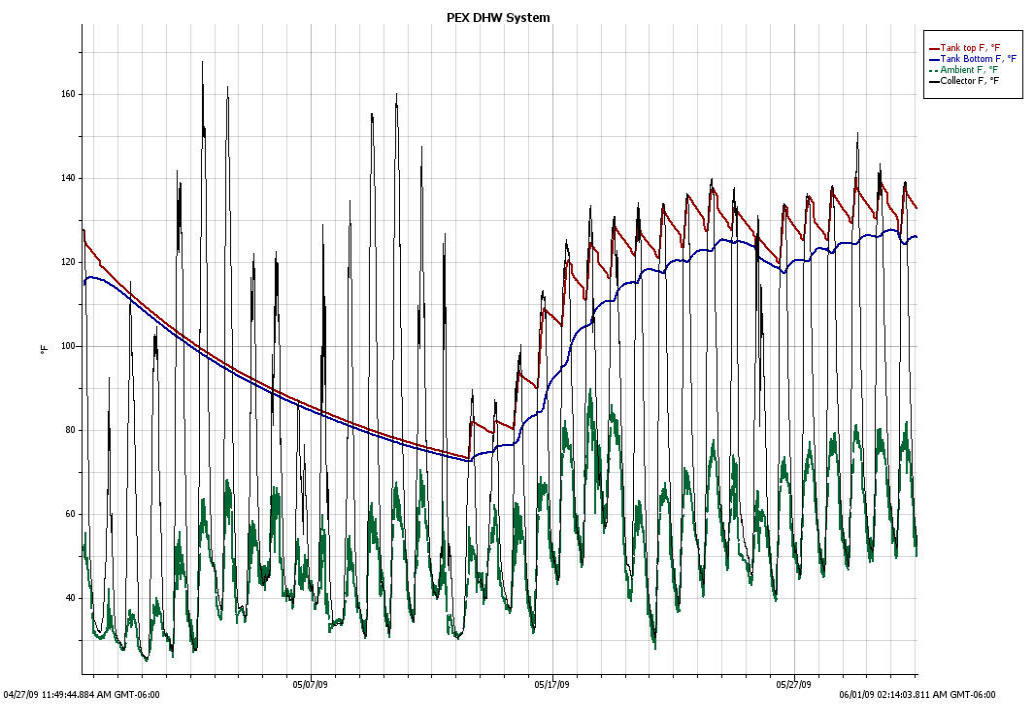
Red -- Top of tank temperature F
Dark Blue -- Bottom of tank
temperature F
Green - Ambient Temperature F
Black - Temperature in the collector
cavity F
The solar fraction was 100% (but see
below).
This months plot requires some "splainin":
We were out of town for the first
half of the month, arriving back on the 14th. During the time we
were out of town, I shut the system down in order to get an idea what the
collector stagnation temps would be, and how fast the tank cools off.
So, for the first part of the month
with the system off, and the collectors stagnated all the time:
Maximum stagnation temps get up
to about 165F -- this is fine, and means the steep tilt (so far) is doing
its job of keeping stagnation temps well below 230F.
During our absence, the tank
average temperature started around 120F and decayed down to 73F over the 16
days.
This rate of decay seems high to
me, and I am working out what the effective R value of the tank is for this
rate of decay. I'll report the results later.
For the 2nd half of the month with
the system on, I counted the solar fraction as 100%:
From the 16th of the month to the
end, its clear this is true, since the tank temp never falls below 110F, and
is mostly around 130F.
For the three days before the
16th, the tank is below 110F while it is recovering from the system being
off for the first half of the month. But, It seems pretty clear when I
look at the sun record for these few days, that had the system been on
earlier in the month, the tank would have been above 110F, so the 100% solar
fraction seems fair to me?
Note that on the 29th and 30th, the
tank reaches 140F, and the controller shuts the pump off to keep the tank
temperature from exceeding 140F. You can see this because the collector
temperature goes up with the pump off, and the collector stagnated. I like
the fact that this is not occurring day after day, and that the collector is not
actually spending a lot of time stagnated -- the solar input is actually fairly
well matched to the demand. It will be interesting to see how this works
out later in the summer.
I think we are settled into late
spring summer weather, which is usually pretty sunny. I would expect June,
July, August and September to have good solar fractions. Going out on a
limb, I would guess that the total year solar faction might turn out around 95%.
This is assigning January (the month we were away) a solar fraction equal to
December (our worst month), and assuming 99% for June, July, and August.
June 2009 --
Solar Fraction 99.5%
This plot covers the month of June
2009
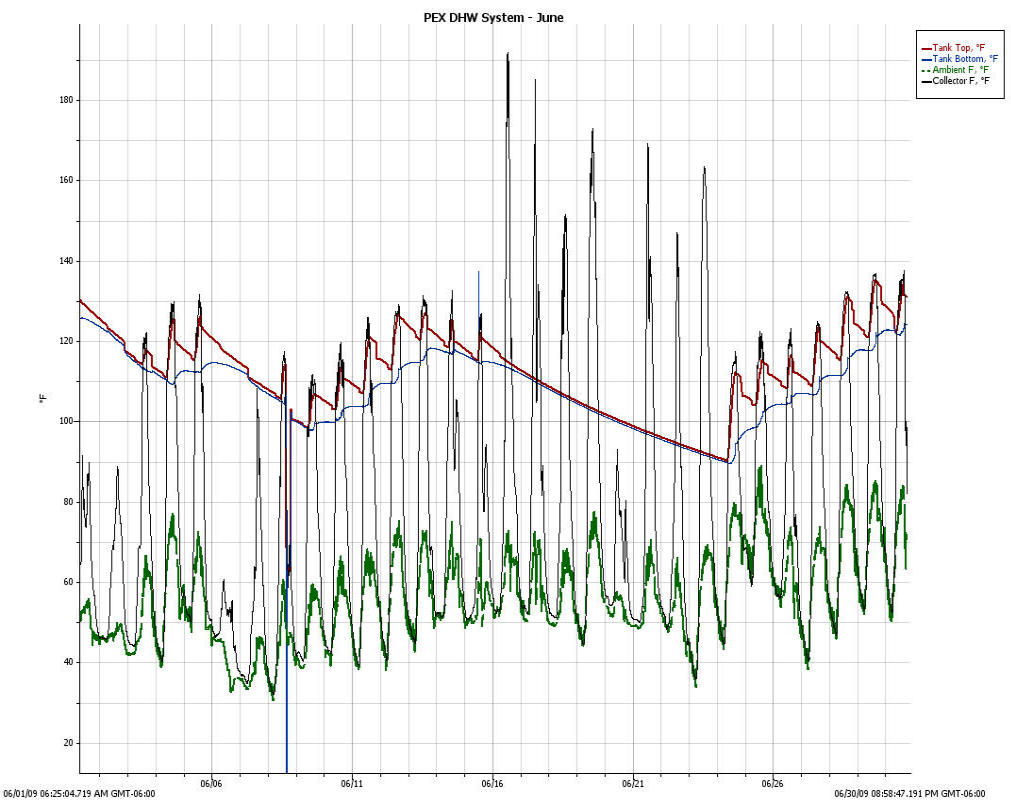
Well, last month, I predicted that
solar fractions for the rest of the summer would be 99%, leading to a year total
of 95%. We had a lot of cloudy weather in June, and I thought that the
fickle Montana weather was going to prove me wrong, but the system (just)
managed to hang in there, and achieved a bit over 99%.
The week starting on the 16th was our
trip back to the MREA, and I shut down the system to do
another heat loss test. This time
period was not counted in the solar fraction calculation.
The last week of the month was pretty
sunny, and the tank has been working its way up into the mid 130's.
The collector was stagnated for the
time of the MREA trip. The maximum collector temperature was 192F on the
17th -- well under the about 230F that I think is an maximum for this PEX
collector. This fairly low stagnation temperature is due mostly to the high
tilt angle. At this time of year, the noon sun is up at about 70
degrees, and makes an incidence angle of 50 degrees with the glazing -- the cosine
of 50 is 0.64, so the sun intensity is down 36% from perpendicular incidence.
The odd data around the 8th is from
doing some work on the tank. I changed the HDPE pipe coil heat exchanger
to a PEX one, and attempted to seal anything that looked suspicious. Also
worked out a way to lag screw the lid down more securely. This was all
aimed at seeing if we could reduce the tank heat loss, which was measured last
month and seemed a bit high. The results of these changes was tested by
doing another heat loss test during our
absence.
I also added a carefully marked dip
stick that measures the water level through the lid. The baseline
measurement for this was June 8, 2009 -- as of June 30, 2009 there was no
detectable drop in tank level whatever.
I think its a good idea to have a
small access hole in the tank lid. In my case this is a short length of
half inch CPVC pipe extending through the lid and the EPDM lining. It is
siliconed in place, and has a small piece of plastic tape over it to keep water
vapor from escaping. The little hole allows you to easily add a water or
chemical, take Ph readings, lower a temperature sensor into the tank, and to
lower a dipstick into to track the tank water level -- all without having to
take the lid off.
July 2009 --
Solar Fraction 100%
This plot covers the month of July
2009
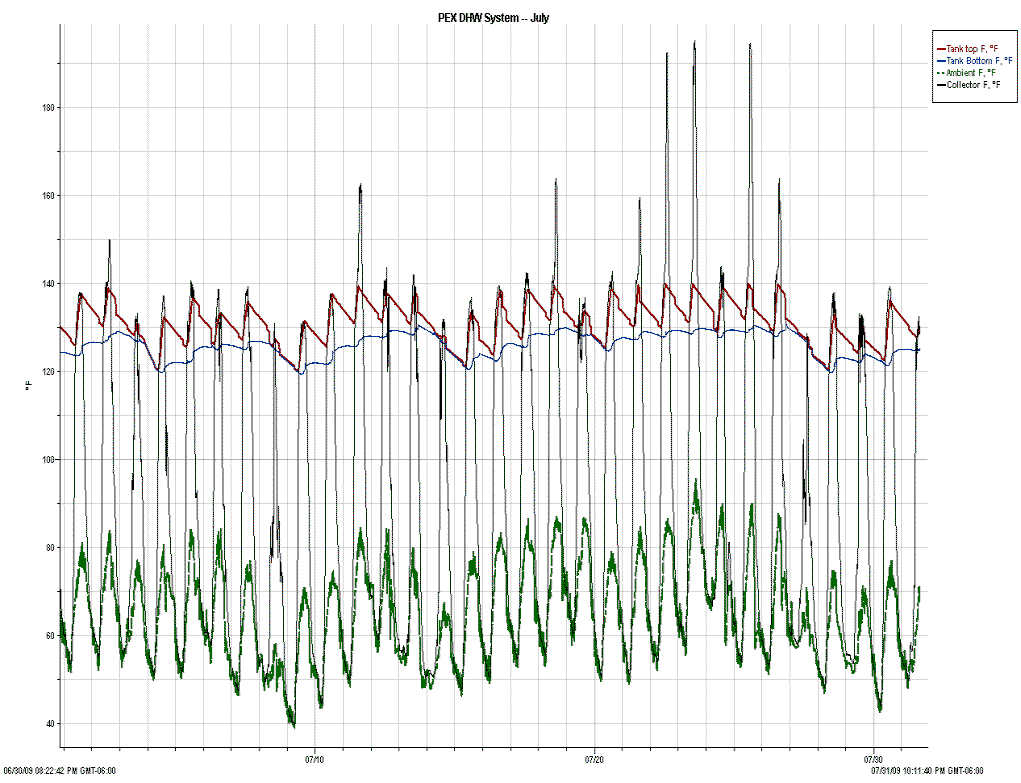
Red -- Top of tank temperature F
Dark Blue -- Bottom of tank
temperature F
Green - Ambient Temperature F
Black - Temperature in the collector
cavity F
This was a pretty sunny month with
warm temperatures. The system achieved a 100% solar fraction, as you might
expect for an "easy" month.
Note that on several days, the tank
temperature reached 140F. At this temperature, the controller shuts off
the pump to prevent the tank water from going over 140F. The idea here is
that (in my view) there is little benefit in letting the temperature go over
140F. On the other hand, keeping the tank at no more than 140F will result
in a very long life for the EPDM liner, and also allows the use of a less
expensive circulation pump since it does not have to handle temperatures above
140F.
The reason that I think there is
little to no benefit in letting the tank temperature go over 140F is that
basically the only times of year that the tank would routinely make it to 140F
and above are in the summer and early fall, and these are times of year with
plenty of sun, so you don't need the extra energy in the tank -- especially with
the large tank capacities that I recommend. In the winter when it would be
nice to have more that 140F in the tank to provide more margin for long
stretches of cold and stormy weather, the combination of less sun and lower
ambient temperatures make it unlikely that you can get the tank up to 140F, let
along get to more than 140F. So, it just seems like letting the tank go
above 140F just makes like hard for the system components with no benefit.
The negative effect of turning the
pump off when then tank gets to 140F is that the collector will be stagnated,
and the collector temperature will go up. While the copper
version of the collector can take high stagnation temperatures, the PEX version
should not go much above 220F. So, on the PEX version, the stagnation
temperature is held down by a combination of high tilt angle and single glazing.
The high tilt angle when combined with a somewhat oversized collector results in
improved collection in the winter (when you really need it), and less collection
in the summer when you don't want it. This is because the sun is low in
the winter and comes in nearly perpendicular to the steeply tilted collector,
but in the winter the sun is high, and makes a large incidence angle with the
collector for less heating. So far, this strategy appears to be working
well, as the stagnation temperatures have remained well below 220F, even with a
couple fully sunny, 95F ambient days.
You could make life easier for the
collector by keeping the pump on, and letting the tank temperature go over 140F.
But, even if you do this, the collector must be able to handle stagnation,
because a pump, controller, or sensor failure is bound to occur at some point --
you don't want the collector to be destroyed just because one of these
components fail.
August 2009 --
Solar Fraction 100%
This plot covers the month of August
2009.
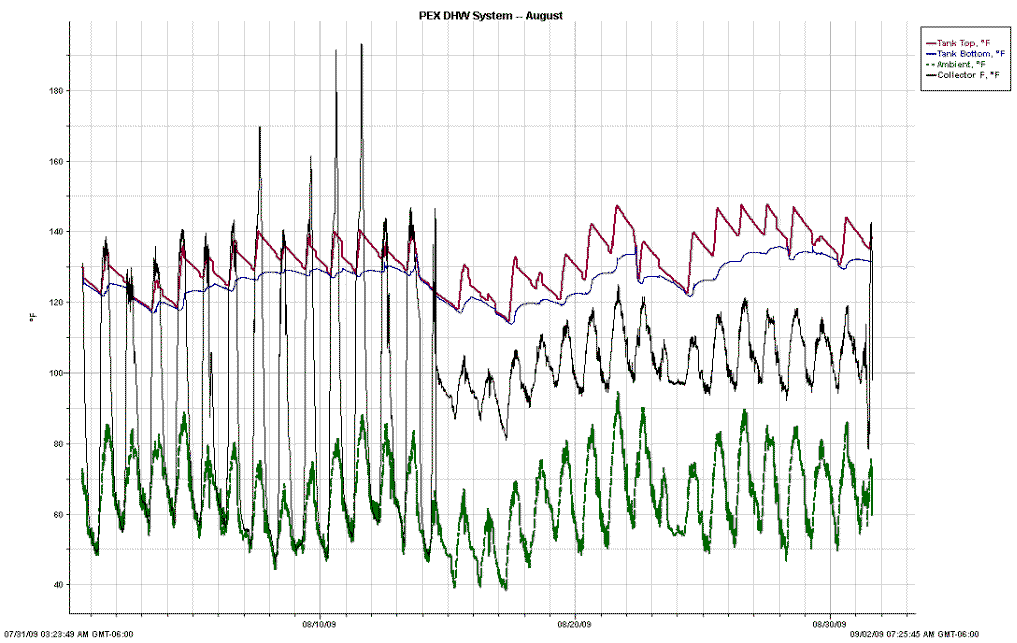
Red -- Top of tank temperature F
Dark Blue -- Bottom of tank
temperature F
Green - Ambient Temperature F
Black - Temperature in the collector
cavity F (NOTE: only valid from Aug 1 to Aug 15 -- see below)
This August in SW Montana may set an
all time record for most precipitation, but there was still quite a bit of sun,
and the system achieved a 100% solar fraction for the month.
The Steca controller failed on the 15
th of the month. This appeared to be the same type of failure as the first
Steca controller. The pump just runs all the time, even when the
controller screen shows it to be shut down. It acts like the output relay
for the pump (if it had one) is stuck.
This failure accounts for the
dip in temperature around the 15th. The pump kept running well into the
evening and cooled the tank down instead of heating it.
I decided after 2 failures, that even
though I like the Steca a lot, it was time to go to something else. I
ordered a Caleffi iSolar 1 to replace the Steca. While waiting for the new
controller to arrive, I used the Goldline controller from my solar space heating
system as a temporary replacement. The Goldline requires a 10K thermistor
for the sensor, which is different than the Steca controller. To avoid
having to install a new 10K sensor, I used the one 10K sensor that was already
installed in the collector for logging collector temperature. So, the
collector temperature log readings are only valid for the time before the 15 th
of the month -- after this the sensor was disconnected from the logger and
connected to the Goldline controller.
The new Caleffi controller was
installed on the 31st and the collector temperature sensor restored to its
logging function. The Caleffi installation only took a few minutes, since
it was able to use the same sensors that were already there for the Steca.
It appears to be working fine so far -- all 6 hours.
I would normally expect the
differential controller to be one of those parts that would go for 20 years
without a hitch, so having two failures in one year is puzzling -- especially
given that the failure appears to be related to the output "relay" that drives
the pump, and the pump only draws 13 watts. Don't know what the
explanation is.
The storage tank again reached 140F
on a few days. At this temperature the controller stops the pump to
prevent the tank from going above 140F. This means that the collector is
stagnated, and you can see that on these days the collector temperatures go up
to about 190F. Again, the steep tilt appears to be controlling the
collector stagnation temperature and keeping it below the 230F or so that the
PEX is good for.
I will keep logging through September
and provide a plot for September -- that will be a full year of plots. I
plan to stop logging at the end of September, and use the logger for other
things.
September 2009 --
Solar Fraction 100%
This plot covers the month of
September
2009.
September
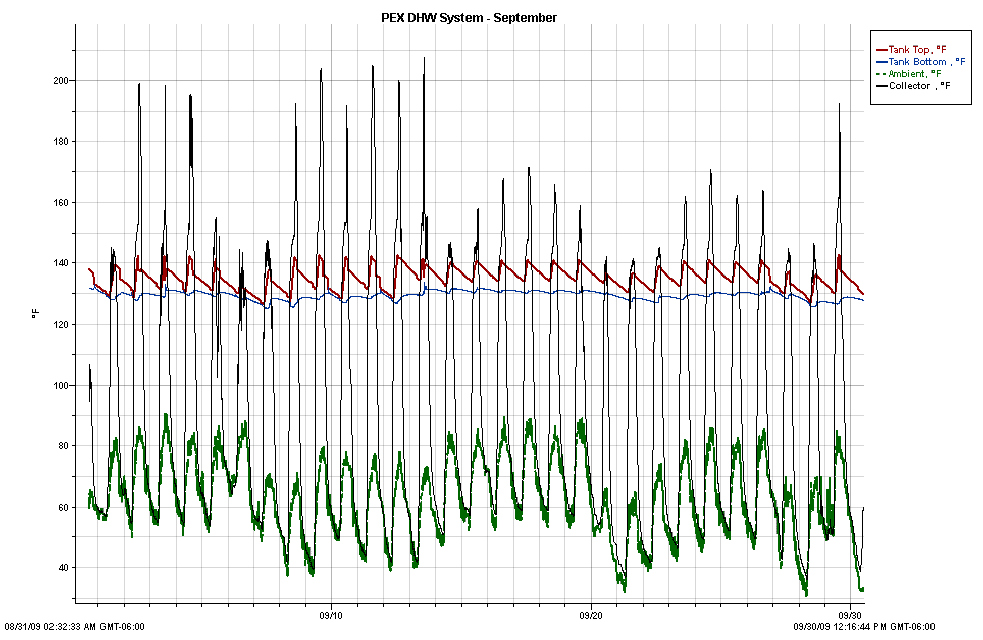
Red -- Top of tank temperature F
Dark Blue -- Bottom of tank
temperature F
Green - Ambient Temperature F
Black - Temperature in the collector
cavity F (NOTE: only valid from Aug 1 to Aug 15 -- see below)
The lowest tank temperature was about
127F, and the tank reached the high limit temperature of 140F nearly every day.
We had quite a bit of sunny weather.
The highest collector temperature was
208F, with most days below 200F. I thought that the stagnation temperature
might be higher than this, because the days are still pretty warm, and the sun
is getting lower in the sky, so the high collector tilt does not protect the
collector as much, but the stagnation temperatures remained below the 220F that
I don't like to go above.
We were out of town from the 14th to
the 26th. During this time. As an experiment to see how well it
controls stagnation temperatures, I installed a shade cloth cover over about the
top 1/3rd of the collector glazing for the time we were gone. This proved
to be quite effective, knocking the stagnation temperatures down by a good 40F
on average. So, this is another potential way to make life a bit easier
for your collector during periods of low demand. It looks like this:

The shade cloth in place. This could be done much more neatly, and with a
nicer
shade cloth color -- perhaps with some kind of rollup feature to make it easy
to roll up or down. It looks pretty opaque in the picture, but it actually
lets
a fair amount of light through.
The new Caleffi controller was
installed for the full month and worked well. It has the additional
feature of keeping track of pump on time. The total pump on time for
September was 105 hours. This would have been higher had we been home for
the full month, and using hot water each day. On the days when we were out
of town, the tank drops a few degrees in temperature overnight from just from
heat loss out the tank walls -- the pump runs for a short time the next to to
get the tank back up to the upper limit of 140F, and then stops.

The new Caleffi
controller. It will display temperatures for the
Collector, Tank, and a 3rd location, and cumulative hours of pump operation
The diagram shows pump operation and also indicates when the
tank has reached
the high limit setting.
So, this marks a full year of
reporting performance as promised, and this will be the last month -- I finally
get my loggers back for other things!
Gary
September 24, 2008, October 9,
2008, October 31, 2008, December 3, 2008, March 31, 2009, April 27, 2009,
June 1, 2009, July 1, 2009, July 31, 2009, August 31, 2009, October 4, 2009
















